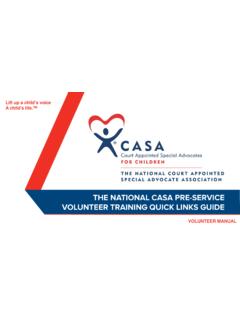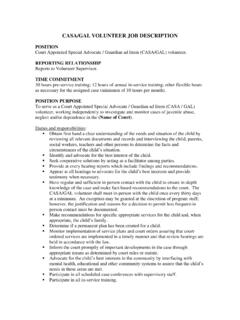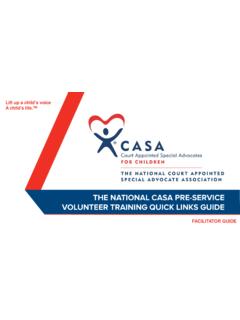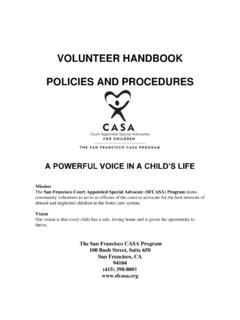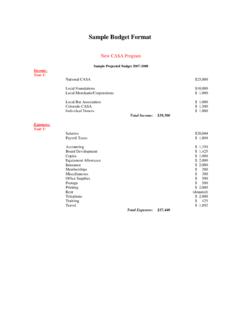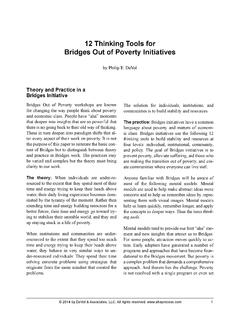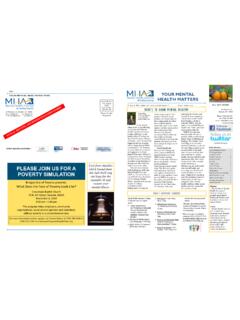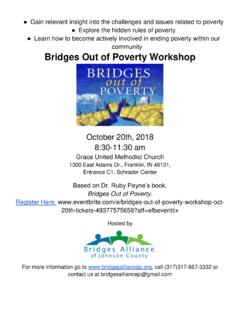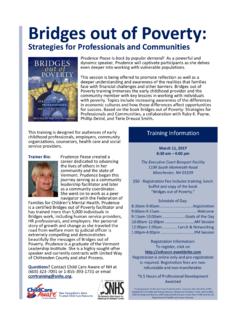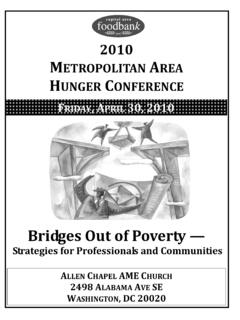Transcription of A Report on a Bridges Out of Poverty Training Summary ...
1 A Report on a Bridges Out of Poverty Training Tracy Evans, Southern Gulf Region Program Officer March 2010 Summary : The Bridges Out of Poverty Training addresses ways we think about Poverty at the individual, organizational and community levels. Although the United States is home to hundreds of billionaires and countless millionaires, the Children s Defense Fund asserts in The State of America's Children 2010 a statistical compendium of key child data that a baby is born into Poverty about every 32 seconds. More than million children are in families living at half the Poverty level or less. Let s take a family of four: that is $919 a month, $212 a week and $30 a day. Yes, you read that $30 a day. As CASA and guardian ad litem staff, our goal is to support and promote court-appointed volunteer advocacy for abused and neglected children.
2 Our volunteers are trained to act as strong voices on the individual needs of these children, giving them the best possible chance at a hopeful future. As such, we cannot ever ignore the impact Poverty can play toward weakening a family s resilience and its ability to cope with the inevitable demands and stresses of day to day life. This past March, the Court Appointed Juvenile Advocates (CAJA) program in Madison County, AL, sponsored a two day seminar, Bridges Out of Poverty , made possible by a National CASA Diversity Grant. Based in part on Ruby Payne's Framework for Understanding Poverty , the Bridges Out of Poverty model offers ideas and tools that can be used by social service providers and community organizations whose daily work connects them with the lives of people who live in Poverty . Shirley Ingram, the CAJA program director, had the inclusive vision to extend an invitation to her CASA colleagues who were interested, along with social workers and juvenile justice staff in the area.
3 The seminar was very well received, and it provided an opportunity for some much-needed cross-disciplinary discussion and collaboration. In a format that makes use of both lecture-style presentation and group activity, the Training uses case studies, analyses, charts and media presentations to examine the causes of Poverty conceptualized within four main categories: behaviors of the individual; human and social capital in the community; exploitation of people in Poverty ; and political/economic structures. After we were introduced to these concepts, we were then able to: discuss generational Poverty versus situational Poverty ; identify the "hidden rules" or social cues that differ greatly between the classes, and examine the impact of economic class differences on communication, interactions, and expectations.
4 Sound heavy? It was. It s good stuff, though. It s engaging. It s interactive and it will change your mind about lots of things you already thought you knew. If you have the opportunity to attend this Training , you ll learn strategies for assessing and changing your program designs and policies and procedures to improve your outcomes. More specifically, you ll get front-line skills to advocate for people in generational and situational Poverty and the relational skills to put the skills to use. No matter your role within the CASA/GAL network, you ll find something useful in the Bridges Out of Poverty Training . It s no small challenge to deal with the systemic issues that keep families in Poverty . As long as Poverty exists, we ll have children and families who enter our circle of care under duress with great need for support, understanding and advocacy, and an even greater need to believe in themselves.
5 For that reason, changes have to take place at the individual, organizational and community levels. Otherwise, for those 2,692 children who will be born into Poverty tomorrow, the chance for that hopeful future will be no greater than for the ones born yesterday. For more information about the Bridges Out of Poverty workshop, go to the
